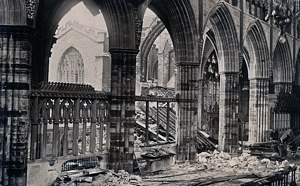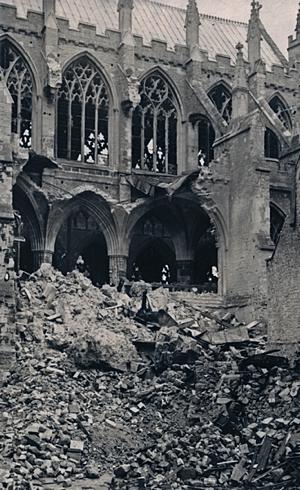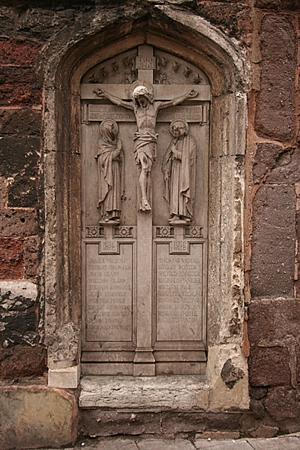
Herbert Read Ltd
A firm run by three generations
Page added 4th November 2013
Return to Industrial Exeter
Although Exeter Cathedral employed many skilled craftsmen and artisans for repair and refurbishment, during the 19th Century, there was a need for craftsman to work on the fabric of the many historic churches in Devon and beyond, as the Victorians went through their ‘return to Gothic’ revival. Probably the most prominent of these craftsmen was Harry Hems, who opened his workshop in Longbrook Street in 1883.
It was with Hem’s that one Herbert Read who was born in Wincanton in 1860, started his career, learning the trade of woodcarving, as practiced for hundreds of years by the many Cathedral wood carvers that had preceded both of them. Soon Read had risen to foreman joiner, or chief designer, and in 1888, he left Hems’ workshop to start up on his own.
Read's workshop, known as the St Sidwell’s Artworks in Sidwell Street, was only around the corner from Harry Hems. Thus was born an Exeter business that would be admired for its fine craftsmanship around the world. He was noted, among other works, for his restoration of the front of the Guildhall. Herbert Read died on the 8 March 1904 of pneumonia, at the early age of 44. Read’s second son, also named Herbert (born 1885) took over the business in 1908. The company specialised in ecclesiastical woodcarving, although they also undertook work for private houses and both commercial and municipal buildings. One church commission, in 1922, was for a 7ft high, carved Calvary group added to the ancient screen of Alphington Parish Church. The year before, a wayside cross at Bow was discovered, and Herbert Read was commissioned to restore it. The cross was re-erected near Langford and dedicated by the Bishop of Crediton. Within Exeter, the First War memorial on the outside of St Olave’s Church, Fore Street is the work of Herbert Read, dating from 1922.
Through the 1930s, the firms of Harry Hems and Herbert Read shared equally the woodcarving market, with Herbert Read perhaps undertaking a little more restoration work. The Harry Hems workshop closed in 1938, leaving Herbert Read Ltd to continue alone, in a very specialised market.
However, it was the Second World War that would provide some of the greatest challenges for the second Herbert Read.
On the night of 4 May 1942, Exeter suffered its worst bombing raid from the Luftwaffe. Thousands of incendiaries fell on the city, destroying two thirds of the High Street and Herbert Read’s own workshop, in Sidwell Street.
Miracle at Exeter Cathedral
One fateful bomb fell on St James’ Chapel, at the Cathedral, taking out two buttresses, leaving the roof dangerously exposed to collapse–the blast blew apart much of the woodwork in the interior, including the screen. Godfrey Allen, a London architect was brought in to oversee the restoration. Herbert Read put his skills at the disposal of the Dean and Chapter, and the task of clearing away the mess, before repair and restoration began.
Herbert Read spent hours retrieving the splinters of timber that once formed the screen and chunks of stone from the sedlia. Once the tens of thousands of fragments had been collected, he embarked on the greatest jigsaw puzzle of all time, carefully fitting the pieces together. Each screen comprised of between a thousand and six thousand pieces, and over time the screen was restored. In April 1947, a new 12ft long, English oak altar designed and made by Herbert Read was consecrated by the Bishop. Not only did Herbert Read work on the Cathedral, but repairs to St Mary Arches Church 14th Century wagon roof, used teak timbers intended for repairing landing craft, that were provided by Herbert Read Ltd.
The second Herbert Read died sometime after he had surgery in a London hospital in 1950, leaving the firm, now based in Topsham, to be run by his son, known as Herbert (Dick) Read.
The company was commissioned to design and make all the important timber interior of Washington DC National Cathedral, a task that took many years. Les Jewell of Herbert Read Ltd was responsible for the carving on Washington Cathedral, as well as work at the Cleveland Heights United Methodist church in Ohio, and churches throughout Kentucky. In 1972, Dick Read died in a boating accident.
Hugh Harrison, who had worked for the firm for only 18 months, took on the task of continuing the tradition of the firm, as conservation became a growing market through the 1970s. They worked on Hampton Court Palace, the House of Lords and even the Taj Mahal, as well as many churches around the globe. The firm ceased trading in the 1990s.
Although much of the firms records were lost in the blitz, some drawings survived, having been moved to another location. These drawings were purchased by the Devon Records Office in 2006, assisted by the Friends of Devon Archives, the Victoria and Albert Museum and the Friends of the National Libraries.
Sources: Western Times, Exeter Cathedral obituary and the Friends of Devon Archives website.
 The damage to the interior of Exeter Cathedral.
The damage to the interior of Exeter Cathedral. The missing butresses at the Cathedral..
The missing butresses at the Cathedral.. The St Olave's War Memorial by Herbert Read, 1922.
The St Olave's War Memorial by Herbert Read, 1922.
│ Top of Page │